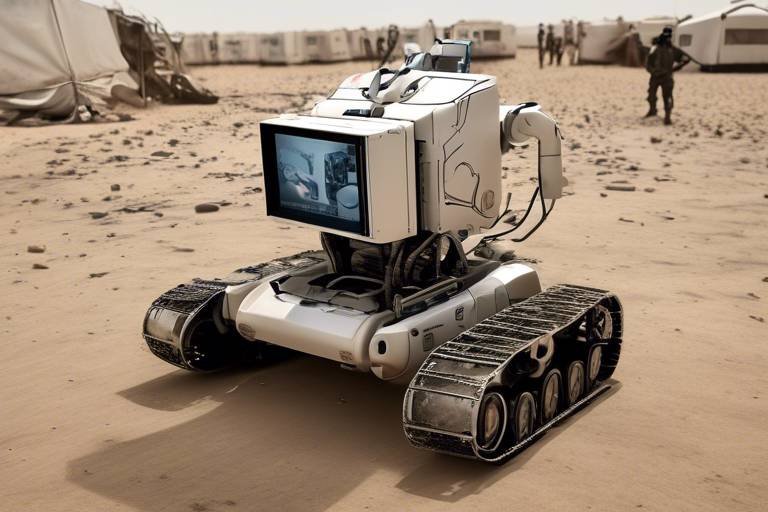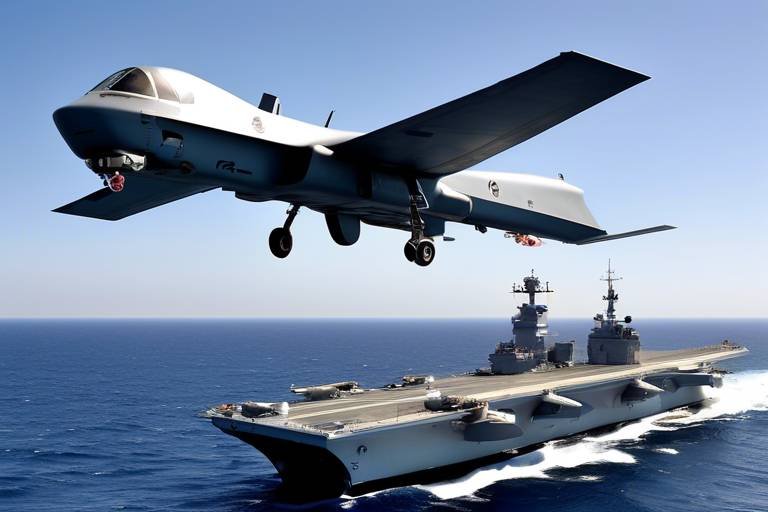Evaluating the Performance of the ROVs in Hazardous Environments
As we delve into the world of Remotely Operated Vehicles (ROVs), it’s essential to recognize their crucial role in navigating the treacherous terrains of hazardous environments. These remarkable machines are not just pieces of technology; they are lifelines in situations where human intervention is risky or outright impossible. Imagine sending a robot into the depths of the ocean or the heart of a disaster zone. It’s like sending a brave knight into a dragon’s lair, armed with the latest gadgets and gizmos to tackle the unknown. This article explores the effectiveness and reliability of ROVs, focusing on their design, technology, and the operational challenges they face in various hazardous environments.
ROVs are sophisticated underwater robots equipped with a variety of sensors and cameras, designed to operate in environments that are perilous for human beings. Their components typically include a hull for buoyancy, thrusters for movement, and manipulator arms for interaction with the environment. Over the years, advancements in technology have drastically improved their performance. For instance, the integration of high-definition cameras allows operators to see in real-time what the ROV is encountering, akin to having a pair of eyes in the depths of the ocean.
Moreover, the development of robust communication systems ensures that ROVs can transmit data back to operators on the surface, even in challenging conditions. This technology not only enhances situational awareness but also empowers operators to make informed decisions quickly. The evolution of ROVs is a testament to human ingenuity, pushing the boundaries of what is possible in hazardous environments.
ROVs are deployed in various hazardous environments, each presenting unique challenges that test their capabilities. Some of the most common environments include:
- Underwater Exploration: From deep-sea oil rigs to submerged wrecks, ROVs navigate extreme pressures and murky waters.
- Nuclear Facilities: In the aftermath of disasters like Fukushima, ROVs are used to inspect and manage radioactive materials.
- Disaster-Stricken Areas: In the wake of earthquakes or floods, ROVs help assess damage and locate survivors in areas that are too dangerous for humans.
Each of these environments poses its own set of challenges, requiring ROVs to be equipped with specialized tools and technology to ensure successful missions.
The design of ROVs is critical to their performance in hazardous environments. Engineers must consider several factors to ensure these machines can withstand extreme conditions. For instance, pressure resistance is paramount for underwater ROVs. The hull must be constructed from materials that can endure the crushing depths of the ocean, often using advanced composites or titanium. Additionally, buoyancy control is vital; ROVs need to maintain stability while performing tasks at varying depths.
Furthermore, the choice of materials impacts not only the durability but also the overall weight of the ROV. A well-balanced design allows for better maneuverability, enabling the ROV to navigate complex environments with ease. In essence, the design of an ROV is a delicate dance of engineering that balances strength, agility, and functionality.
Recent technological innovations have significantly enhanced ROV capabilities. Enhanced sensors now allow for detailed environmental analysis, providing data on temperature, pressure, and even chemical composition. This is akin to giving the ROV a set of super senses, allowing it to 'feel' its surroundings. Improved navigation systems, such as GPS and sonar, enable ROVs to traverse challenging terrains more effectively, making them invaluable in search and rescue missions.
Moreover, advancements in communication tools ensure that operators can maintain a steady connection with ROVs, even in the most remote locations. This constant feedback loop is crucial for mission success, as it allows for real-time adjustments and decision-making.
Despite their advanced design and technology, ROVs face numerous operational challenges in hazardous environments. Limited visibility underwater can make navigation tricky, often requiring operators to rely on sonar and other non-visual cues. Strong currents can push ROVs off course, demanding precise control and quick reflexes from operators.
Additionally, equipment failures can occur, whether due to mechanical issues or external factors like debris. These challenges necessitate a high level of training for operators and a robust support system to ensure that ROVs can be deployed effectively in any situation.
Examining real-world deployments provides invaluable insights into the effectiveness of ROVs. For example, during the Deepwater Horizon oil spill, ROVs played a crucial role in assessing the damage and managing the crisis. They were able to dive deep into the Gulf of Mexico, capturing footage and collecting data that guided response efforts. This case highlights not only the operational capabilities of ROVs but also the importance of having reliable technology in place during emergencies.
Safety is paramount when operating ROVs in hazardous environments. Operators must adhere to strict protocols to minimize risks. These protocols include pre-mission checks, regular maintenance, and real-time monitoring of ROV systems. Operators are trained to respond quickly to any anomalies, ensuring that both the ROV and the mission are safeguarded.
Looking ahead, the future of ROV technology is bright. We can expect to see advancements in artificial intelligence, enabling ROVs to make autonomous decisions based on real-time data. This could revolutionize their deployment in hazardous environments, reducing the need for constant human oversight. Additionally, as battery technology improves, ROVs will be able to operate for longer durations, expanding their capabilities even further.
- What are ROVs primarily used for? ROVs are used for underwater exploration, inspections, and data collection in hazardous environments.
- How deep can ROVs operate? Depending on their design, some ROVs can operate at depths of over 6,000 meters.
- What are the main challenges faced by ROVs? Limited visibility, strong currents, and equipment failures are significant challenges ROVs encounter.
- How do ROVs communicate with operators? ROVs typically use fiber optic cables or radio signals to transmit data back to the surface.

Introduction to ROV Technology
Remotely Operated Vehicles, or ROVs, have revolutionized the way we explore and interact with hazardous environments. Imagine sending a tiny robot into the depths of the ocean or the ruins of a disaster site, all while you sit safely on land. That's the magic of ROV technology! These vehicles are equipped with advanced components that allow them to navigate and operate in conditions that would be perilous for human beings.
At the heart of ROV technology lies a combination of sophisticated engineering and cutting-edge electronics. Typically, an ROV consists of several key components:
- Frame: The sturdy skeleton that provides structural integrity.
- Propulsion System: Thrusters that enable movement in various directions.
- Cameras and Sensors: Essential for capturing visual data and monitoring environmental conditions.
- Control System: The brain of the ROV that processes information and commands.
- Communication System: Facilitates data transmission between the ROV and the operator.
Over the years, significant advancements in technology have enhanced the performance of ROVs in hazardous environments. For instance, the introduction of high-definition cameras and advanced sonar systems has vastly improved the ability to see and understand complex surroundings. This is particularly vital in murky waters or disaster zones where visibility is severely limited.
Moreover, ROVs are designed to withstand extreme conditions. Whether it’s the crushing pressure of deep-sea exploration or the high radiation levels in nuclear sites, these vehicles are built with robust materials and innovative designs that ensure they can operate safely and effectively. The evolution of materials such as carbon fiber and titanium has allowed manufacturers to create lighter yet stronger ROVs, which can maneuver better and reach places that were previously inaccessible.
In addition to their physical design, the operational capabilities of ROVs have also improved. Enhanced navigation systems, powered by GPS and advanced algorithms, allow ROVs to traverse challenging terrains with precision. This is crucial when working in environments that pose risks, as it minimizes the chances of equipment failure or accidents.
As we delve deeper into the world of ROV technology throughout this article, we will explore not only the various types of hazardous environments where these vehicles are deployed but also the operational challenges they face and the future of this remarkable technology. Buckle up, because the journey into the depths of ROV capabilities is just beginning!
- What are the primary uses of ROVs? ROVs are commonly used in underwater exploration, search and rescue operations, and inspections of hazardous sites such as nuclear plants.
- How deep can ROVs operate? Many ROVs are designed to operate at depths exceeding 6,000 meters, making them suitable for deep-sea exploration.
- Are ROVs controlled remotely? Yes, ROVs are operated remotely by a pilot who uses a control system to navigate and manage the vehicle.
- What types of sensors do ROVs use? ROVs can be equipped with a variety of sensors, including cameras, sonar, temperature gauges, and chemical sensors to gather data from their environment.

Types of Hazardous Environments
When we think about hazardous environments, the mind often conjures up images of perilous situations that demand specialized equipment and expert handling. Remotely Operated Vehicles (ROVs) have become indispensable tools in navigating these treacherous terrains. From the depths of the ocean to the aftermath of natural disasters, ROVs are designed to perform in conditions that would be too dangerous for human operators. Let's dive deeper into some of the most challenging environments where ROVs are deployed.
One of the most notable environments is the underwater realm. Here, ROVs are tasked with exploring the mysterious depths of oceans and lakes, often at significant depths where human divers cannot venture. The pressure increases dramatically as you descend, making it crucial for ROVs to be engineered with robust materials that can withstand these extreme conditions. Not only do they have to endure high pressure, but they also must contend with low temperatures, strong currents, and limited visibility. The design of ROVs for underwater operations often includes features like pressure-resistant casings, specialized lights, and advanced sonar systems to navigate and gather data in these murky waters.
Another hazardous environment where ROVs shine is in nuclear facilities. These areas present unique challenges, including radiation exposure and the need for remote handling of potentially dangerous materials. ROVs equipped with radiation sensors and robotic arms can conduct inspections, perform maintenance, and even handle hazardous waste without putting human lives at risk. In these scenarios, the reliability and precision of ROVs are paramount. Operators can control them from a safe distance, ensuring that critical tasks are completed without exposing personnel to harmful radiation.
Disaster-stricken areas, such as those affected by earthquakes, floods, or industrial accidents, also rely heavily on ROV technology. In these chaotic environments, ROVs can be deployed to assess damage, locate survivors, and gather vital information for rescue teams. They can navigate through debris, providing real-time visuals and data that are crucial for effective response efforts. The ability of ROVs to operate in unstable conditions—where traditional vehicles might fail—demonstrates their versatility and importance in emergency situations.
Moreover, ROVs are increasingly utilized in hazardous environments related to oil and gas exploration. Deep-sea drilling operations often involve high-risk scenarios where equipment failure can lead to catastrophic consequences. ROVs equipped with advanced monitoring systems can inspect rigs, pipelines, and underwater structures, ensuring that everything is functioning as it should. Their ability to operate in high-pressure and corrosive environments makes them essential in preventing spills and ensuring the safety of these critical operations.
In summary, ROVs are deployed in a variety of hazardous environments, each presenting its own unique challenges. The key environments include:
- Underwater Environments: Deep-sea exploration, where pressure and visibility are significant concerns.
- Nuclear Facilities: Areas requiring remote handling due to radiation hazards.
- Disaster Zones: Locations affected by natural disasters needing rapid assessment and response.
- Oil and Gas Exploration: High-risk environments requiring thorough inspections and monitoring.
As we continue to explore and exploit these hazardous environments, the role of ROVs will only grow in importance. Their ability to perform tasks in dangerous conditions not only enhances our understanding of these environments but also ensures the safety of human operators.
- What are ROVs? ROVs, or Remotely Operated Vehicles, are unmanned, remote-controlled machines designed to operate in hazardous environments.
- How do ROVs navigate underwater? ROVs are equipped with advanced sonar systems and cameras that allow them to navigate and gather data in low-visibility conditions.
- Can ROVs operate in nuclear environments? Yes, ROVs are designed to handle tasks in nuclear facilities, equipped with radiation sensors and robotic arms for remote handling.
- What are the benefits of using ROVs in disaster response? ROVs can assess damage, locate survivors, and gather vital information without putting human lives at risk.

Design Considerations for ROVs
When it comes to designing Remotely Operated Vehicles (ROVs) for hazardous environments, there are several critical considerations that engineers must keep in mind. These vehicles are not just machines; they are lifelines in extreme conditions, and their design can mean the difference between success and failure. First and foremost, pressure resistance is paramount. ROVs often operate at depths where the pressure is immense, and any weakness in the structure can lead to catastrophic failure. Engineers typically use robust materials like titanium or specially formulated composites to ensure that the ROV can withstand these harsh conditions.
Another significant factor is material selection. The materials used in ROV construction must not only be strong but also resistant to corrosion, especially in underwater environments. Saltwater can be particularly damaging, so coatings and treatments are often applied to protect sensitive components. Additionally, buoyancy control is crucial. ROVs must maintain a stable position in the water to perform tasks effectively. This is achieved through a careful balance of weights and buoyant materials, allowing the vehicle to hover, ascend, or descend as needed.
Moreover, the design of the ROV’s propulsion system plays a critical role in maneuverability. In turbulent waters or environments with strong currents, having a reliable and agile propulsion system can mean the difference between navigating successfully and being tossed about like a cork. Engineers often opt for multiple thrusters positioned strategically around the ROV to enhance its agility and control.
To further illustrate these design considerations, let's take a look at the following table that summarizes the key elements:
| Design Element | Consideration | Impact on Performance |
|---|---|---|
| Pressure Resistance | Use of durable materials like titanium | Prevents structural failure at depth |
| Material Selection | Corrosion-resistant coatings | Enhances longevity and reliability |
| Buoyancy Control | Balanced weights and buoyant materials | Ensures stability during operations |
| Propulsion System | Multiple strategically placed thrusters | Improves maneuverability and control |
In addition to these technical aspects, the ergonomics of the ROV's design should not be overlooked. The layout of controls, ease of maintenance, and accessibility of components can significantly affect operational efficiency. For instance, if a part needs to be replaced during a mission, having a design that allows quick access can save valuable time and resources.
Finally, the integration of advanced technology into the design is becoming increasingly important. Modern ROVs are equipped with sophisticated sensors and cameras that provide real-time data and visuals, allowing operators to make informed decisions on the fly. This technological integration requires careful planning in the design phase to ensure that all components work harmoniously together.
- What is the most critical design feature of an ROV? Pressure resistance is often considered the most critical feature, as it ensures the vehicle can operate at extreme depths without failing.
- How do ROVs maintain stability underwater? ROVs use a combination of buoyancy control and strategically placed thrusters to maintain stability and maneuverability.
- What materials are commonly used in ROV construction? Common materials include titanium, high-strength composites, and corrosion-resistant coatings to withstand harsh environments.

Technological Advancements in ROVs
In the ever-evolving landscape of technology, Remotely Operated Vehicles (ROVs) have made significant strides, particularly in their ability to operate in hazardous environments. These advancements not only enhance their performance but also expand their applicability across various industries. Imagine sending a machine into the depths of the ocean or a disaster zone, where human presence would be perilous. This is where ROVs shine, equipped with cutting-edge technology that allows them to perform intricate tasks while ensuring safety and efficiency.
One of the most notable advancements in ROV technology is the integration of high-definition cameras and advanced imaging systems. These allow operators to have a clear view of the surroundings, even in murky waters or dark environments. With features like 4K resolution and 360-degree views, ROVs can capture detailed images and videos, providing crucial information for analysis and decision-making. This capability is particularly beneficial in underwater exploration and search-and-rescue missions, where visibility is often a challenge.
Moreover, the development of enhanced sensors has revolutionized how ROVs interact with their environment. Modern ROVs are now equipped with sensors that can measure temperature, pressure, and chemical compositions, allowing them to gather data that was previously difficult to obtain. For instance, in nuclear disaster zones, ROVs can measure radiation levels without putting human lives at risk. This data is invaluable for assessing the situation and planning subsequent actions.
Another significant leap in ROV technology is the improvement in navigation systems. Traditional navigation methods often faced challenges in unpredictable environments. However, the latest ROVs utilize advanced GPS systems, sonar, and inertial navigation to maintain precise positioning. This means they can operate effectively in strong currents or complex underwater terrains, which is essential for tasks such as underwater construction or inspection of submerged infrastructure.
Communication technology has also seen remarkable improvements. ROVs now employ real-time data transmission systems that allow operators to receive live feedback from the vehicle. This is crucial during critical operations where every second counts. For example, in oil rig inspections or underwater repairs, having immediate access to data can make the difference between success and failure.
Lastly, the materials used in ROV construction have evolved to withstand extreme conditions. The use of lightweight yet durable materials, such as carbon fiber and advanced composites, ensures that ROVs can endure high pressures and corrosive environments. This not only extends their operational lifespan but also reduces the overall weight, making them more agile and easier to maneuver.
In summary, the technological advancements in ROVs have transformed them into indispensable tools for various industries facing hazardous conditions. With improvements in imaging, sensing, navigation, communication, and materials, ROVs are more capable than ever before. As we look to the future, these innovations promise to enhance the safety and efficiency of operations in environments that were once deemed too dangerous for human intervention.
- What are ROVs primarily used for? ROVs are used in various applications, including underwater exploration, oil and gas inspections, search and rescue missions, and environmental monitoring.
- How do ROVs communicate with operators? ROVs typically use real-time data transmission systems, often utilizing fiber optic cables or wireless communication technologies to relay information back to the operators.
- What safety measures are in place for ROV operations? Operators follow strict safety protocols, including pre-mission checks, real-time monitoring, and emergency response plans to ensure safe operations in hazardous environments.
- Can ROVs operate in extreme conditions? Yes, modern ROVs are designed to withstand extreme pressures, temperatures, and corrosive environments, making them suitable for a wide range of hazardous situations.

Operational Challenges Faced by ROVs
When it comes to deploying Remotely Operated Vehicles (ROVs) in hazardous environments, the journey is anything but smooth sailing. These high-tech machines are designed to tackle the most challenging conditions, but they often face a myriad of operational hurdles that can impede their effectiveness. Imagine trying to navigate a maze while blindfolded; that’s often the reality for ROV operators as they contend with various unpredictable factors.
One of the primary challenges is limited visibility. Whether submerged in murky waters or surrounded by debris in a disaster zone, visibility can drop to near zero. ROVs rely heavily on cameras and sensors to navigate and perform tasks, but when the environment is obscured, it can lead to disorientation and mistakes. To combat this, operators may use advanced sonar systems, but even that comes with its own set of limitations.
Another significant hurdle is dealing with strong currents. Underwater ROVs, for instance, can be swept off course by powerful ocean currents, making it difficult to maintain a steady position. This instability can affect the ROV's ability to complete its mission, whether it’s inspecting underwater pipelines or conducting search-and-rescue operations. Operators must often deploy additional stabilization measures, which can complicate the logistics of the operation.
Equipment failures present another challenge that can occur at the most inopportune moments. ROVs are complex machines with many moving parts, and the harsh conditions can lead to wear and tear. Imagine being in a critical situation only to have your lifeline cut due to a malfunctioning camera or a faulty thruster. This is why routine maintenance and pre-deployment checks are crucial, but they can be time-consuming and costly.
Moreover, the communication barriers between the ROV and the surface team can create a significant operational challenge. ROVs often operate at depths where radio signals cannot penetrate, which means operators rely on acoustic communication systems. These systems can be slow and prone to errors, leading to miscommunication and potentially jeopardizing the mission.
To give you a clearer picture, here’s a summary table of the operational challenges faced by ROVs:
| Operational Challenge | Description |
|---|---|
| Limited Visibility | Obscured environments reduce the effectiveness of cameras and sensors. |
| Strong Currents | Powerful underwater currents can disrupt navigation and positioning. |
| Equipment Failures | Malfunctions can occur due to harsh conditions, affecting mission success. |
| Communication Barriers | Acoustic communication can be slow and prone to errors, complicating operations. |
In conclusion, while ROVs are remarkable tools for exploring and operating in hazardous environments, they are not without their challenges. Operators must navigate a complex landscape of visibility issues, environmental forces, equipment reliability, and communication hurdles. Each mission requires careful planning and adaptability to ensure success. With advancements in technology and ongoing training, the hope is that these challenges can be mitigated, allowing ROVs to perform even better in the face of adversity.
- What are the main challenges faced by ROVs in hazardous environments?
The main challenges include limited visibility, strong currents, equipment failures, and communication barriers.
- How do operators manage limited visibility?
Operators often use advanced sonar systems and rely on pre-mission planning to navigate through low-visibility conditions.
- What can cause equipment failures in ROVs?
Harsh environmental conditions, wear and tear, and mechanical stress can lead to equipment failures during operations.
- How is communication maintained with ROVs at depth?
Operators use acoustic communication systems, though they can be slower and less reliable than traditional methods.

Case Studies of ROV Deployments
When it comes to deploying Remotely Operated Vehicles (ROVs) in hazardous environments, real-world case studies provide invaluable insights into their performance and capabilities. These examples not only showcase the effectiveness of ROV technology but also highlight the challenges faced and overcome during critical missions. Let's dive into some remarkable instances where ROVs have made a significant impact.
One of the most notable case studies involves the use of ROVs during the Deepwater Horizon oil spill in 2010. In this catastrophic event, ROVs played a crucial role in assessing the damage and monitoring the underwater leak. Equipped with advanced cameras and sensors, these vehicles provided real-time data to engineers and scientists, allowing them to devise strategies for containment and cleanup. The ROVs operated at depths of over 5,000 feet, facing extreme pressure and visibility challenges, yet they delivered critical information that was vital for the response efforts.
Another compelling case study took place in the aftermath of the Fukushima nuclear disaster in Japan. ROVs were deployed to inspect the damaged reactors and assess radiation levels in areas that were too dangerous for human workers. These vehicles were equipped with specialized radiation sensors and high-definition cameras, enabling them to navigate the perilous environment and gather essential data. The information collected by the ROVs was instrumental in understanding the extent of the damage and planning the decommissioning of the facility.
In the realm of underwater exploration, ROVs have also been pivotal in archaeological discoveries. For instance, the exploration of the Titanic wreck site utilized ROV technology to capture stunning visuals and gather artifacts from the ocean floor. These vehicles, capable of maneuvering in the dark depths of the Atlantic, provided researchers with insights into the ship's condition and the surrounding environment. The use of ROVs in such delicate operations underscores their versatility and importance in various fields.
Moreover, ROVs have been employed in the inspection and maintenance of offshore oil rigs. For example, during routine inspections, ROVs equipped with manipulators can perform tasks such as cleaning, repairs, and equipment checks without the need for divers. This not only enhances safety but also reduces downtime for the rigs, proving to be a cost-effective solution for operators. The ability of ROVs to operate in challenging conditions, such as strong currents and low visibility, makes them indispensable in the oil and gas industry.
The lessons learned from these case studies emphasize the importance of continuous improvement in ROV technology. As challenges evolve, so too must the capabilities of these vehicles. Key takeaways include the necessity for robust design, advanced sensor technology, and effective communication systems, all of which contribute to successful ROV deployments in hazardous environments.
- What are ROVs used for? ROVs are primarily used for underwater exploration, inspection, and maintenance in hazardous environments, such as oil spills, nuclear sites, and archaeological digs.
- How deep can ROVs operate? ROVs can operate at various depths, depending on their design and purpose. Some are capable of reaching depths of over 20,000 feet.
- Are ROVs safe to use in hazardous environments? Yes, ROVs are designed to withstand extreme conditions, making them a safe alternative to human divers in dangerous situations.
- What advancements are being made in ROV technology? Recent advancements include improved sensors, better navigation systems, and enhanced communication tools, all aimed at increasing ROV efficiency and reliability.

Safety Protocols for ROV Operations
When it comes to operating Remotely Operated Vehicles (ROVs) in hazardous environments, safety is not just a protocol; it’s a lifeline. The complexities of remote operation, combined with the unpredictable nature of these environments, necessitate a comprehensive approach to safety. Operators must be equipped with a clear understanding of the protocols that govern ROV missions to mitigate risks and ensure successful operations.
First and foremost, pre-mission planning is crucial. This involves a thorough risk assessment that evaluates the specific conditions of the environment where the ROV will be deployed. Operators should consider factors such as water currents, visibility, and potential hazards like underwater debris or toxic substances. By identifying these risks ahead of time, teams can develop strategies to address them effectively. For instance, if strong currents are anticipated, operators may choose to deploy the ROV at a time when conditions are calmer or utilize tethering systems to maintain control.
Next, equipment checks are non-negotiable. Before any mission, a detailed inspection of the ROV and its components must be conducted. This includes checking the integrity of the hull, the functionality of the cameras and sensors, and the reliability of the communication systems. A systematic checklist can help ensure that no detail is overlooked. Here’s a simple example of what that checklist might look like:
| Component | Check | Status |
|---|---|---|
| Hull Integrity | Inspect for cracks or leaks | Pass/Fail |
| Cameras | Test for clarity and functionality | Pass/Fail |
| Communication Systems | Check signal strength | Pass/Fail |
| Propulsion System | Test motors | Pass/Fail |
Furthermore, operators should establish communication protocols that ensure constant contact between the ROV and the control team. This is particularly vital in hazardous environments where visual contact may be limited. Utilizing multiple communication channels, such as acoustic modems and radio systems, can provide redundancy and enhance operational safety. In addition, teams should conduct regular training sessions to familiarize all personnel with emergency procedures, ensuring that everyone knows their role in the event of a malfunction or unexpected situation.
Another essential aspect of ROV safety protocols is real-time monitoring. During operations, it’s critical to have a dedicated team monitoring the ROV’s performance and the environment. This allows for immediate response to any anomalies, such as equipment failures or environmental changes. Implementing software that provides real-time data analytics can significantly enhance situational awareness, allowing operators to make informed decisions on the fly.
Finally, it’s imperative to conduct a post-mission review. After each deployment, teams should analyze the mission’s outcomes, discuss any challenges faced, and identify areas for improvement. This debriefing process not only enhances future missions but also fosters a culture of safety and continuous learning within the organization.
In conclusion, safety protocols for ROV operations are multifaceted and require diligence at every stage of the mission. From pre-mission planning to post-mission analysis, every step is crucial in ensuring the safety of both the ROV and the personnel involved. By adhering to these protocols, operators can navigate the complexities of hazardous environments with greater confidence and effectiveness.
- What are the main risks associated with ROV operations? The main risks include equipment failure, environmental hazards, and communication breakdowns.
- How often should equipment checks be performed? Equipment checks should be performed before every mission, as well as during regular maintenance schedules.
- What training is required for ROV operators? Operators should receive training on equipment handling, emergency procedures, and environmental awareness.
- Can ROVs operate in all hazardous environments? While ROVs are versatile, their effectiveness can vary based on the specific challenges of each environment.

The Future of ROV Technology
As we look toward the horizon of technological advancements, the future of Remotely Operated Vehicles (ROVs) is not just bright; it’s positively dazzling! Imagine a world where ROVs are equipped with cutting-edge features that not only enhance their performance but also broaden their applications across various hazardous environments. With the rapid pace of innovation, we can expect to see ROVs that are smarter, more resilient, and incredibly efficient.
One of the most exciting developments on the horizon is the integration of artificial intelligence (AI) into ROV systems. AI can significantly improve the decision-making processes of ROVs, enabling them to navigate complex environments with minimal human intervention. Picture an ROV that can learn from its surroundings, adapting to challenges in real-time. This capability could revolutionize operations in disaster-stricken areas, where every second counts.
Moreover, advancements in sensor technology are set to enhance ROV capabilities dramatically. Future ROVs will likely be equipped with an array of sophisticated sensors that can detect changes in temperature, pressure, and even chemical composition. This means they could be deployed in environments previously deemed too dangerous for human operators, such as nuclear sites or deep underwater explorations. The ability to gather and analyze data in real-time will empower operators with critical information, leading to better decision-making and safer missions.
Another area poised for growth is communication technology. Current ROVs often struggle with limited communication capabilities, especially when operating in deep water or obstructed areas. However, advancements in underwater communication systems—such as acoustic modems and advanced tethering techniques—are paving the way for uninterrupted data transmission. Imagine an ROV that can stream high-definition video back to the surface in real-time, providing operators with a clear view of the situation, no matter how challenging the environment.
In addition to these technological advancements, the design of ROVs is also evolving. Future models are likely to feature modular designs that allow for easy upgrades and repairs. This flexibility will not only extend the lifespan of ROVs but also make them more adaptable to various missions. For instance, an ROV originally designed for underwater exploration could be easily modified for use in search and rescue operations in disaster zones, showcasing its versatility.
Of course, with innovation comes the need for stringent safety protocols. As ROVs become more advanced, ensuring their safe operation will be paramount. Future ROV technology will likely incorporate built-in safety measures, such as automatic shutdown systems and fail-safes, to prevent accidents and ensure the safety of both the ROV and its operators.
In summary, the future of ROV technology is not just about making better machines; it's about creating intelligent, adaptable systems that can tackle the most challenging environments. With the integration of AI, advanced sensors, improved communication, and modular designs, ROVs are set to become indispensable tools in hazardous operations. As we embrace these technological advancements, we can look forward to a future where ROVs not only enhance our capabilities but also ensure the safety and efficiency of missions in perilous conditions.
- What are ROVs primarily used for?
ROVs are used for various applications, including underwater exploration, inspection of underwater infrastructure, search and rescue operations, and environmental monitoring. - How do ROVs communicate with operators?
ROVs typically communicate through tethered cables or wireless communication systems, depending on the environment they are operating in. - What are the main challenges faced by ROVs in hazardous environments?
Challenges include limited visibility, strong currents, equipment failures, and the need for real-time data transmission. - How is AI expected to improve ROV operations?
AI can enable ROVs to make autonomous decisions, adapt to changing conditions, and improve overall mission efficiency.
Frequently Asked Questions
- What are ROVs and how do they work?
ROVs, or Remotely Operated Vehicles, are unmanned, remotely controlled machines designed to operate in hazardous environments. They are equipped with cameras, sensors, and tools that allow operators to perform tasks underwater or in dangerous locations without putting human lives at risk. Imagine sending a robot into the depths of the ocean or a disaster zone—ROVs do just that!
- What types of hazardous environments are ROVs used in?
ROVs are deployed in a variety of hazardous environments, including underwater sites, nuclear facilities, and areas affected by natural disasters. Each of these locations presents unique challenges, like extreme pressure underwater or radiation in nuclear sites, making ROVs an invaluable resource for exploration and recovery operations.
- What design features make ROVs suitable for extreme conditions?
To withstand extreme conditions, ROVs are designed with several critical features, such as pressure resistance, specialized materials, and buoyancy control mechanisms. These elements ensure that they can operate effectively, whether they're deep in the ocean or navigating through debris in disaster-stricken areas.
- What technological advancements have improved ROV performance?
Recent technological advancements have significantly enhanced ROV capabilities. Innovations like improved sensors, advanced navigation systems, and better communication tools allow ROVs to operate more efficiently and effectively in challenging environments. It's like giving these machines a brain that helps them make smarter decisions on the fly!
- What operational challenges do ROVs face?
ROVs encounter several operational challenges, including limited visibility, strong underwater currents, and potential equipment failures. These factors can complicate missions and require skilled operators to adapt quickly to changing conditions, much like navigating through a stormy sea.
- Can you provide examples of successful ROV deployments?
Absolutely! There are numerous case studies showcasing successful ROV deployments. For instance, ROVs have been used to inspect underwater pipelines, assist in search and recovery missions after disasters, and even explore shipwrecks. Each case offers valuable lessons and best practices for future operations.
- What safety protocols should be followed during ROV operations?
Safety protocols for ROV operations are crucial to ensure the success of missions and the safety of operators. These include thorough pre-mission checks, continuous monitoring during operations, and having contingency plans in place for emergencies. Think of it as a safety net that protects both the equipment and the people behind it.
- What does the future hold for ROV technology?
The future of ROV technology looks promising, with potential developments that could enhance their performance and broaden their applications. Innovations like AI integration, improved autonomy, and enhanced power sources could revolutionize how ROVs are used in hazardous environments, making them even more effective in the years to come.



















